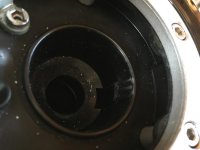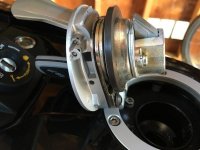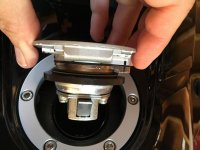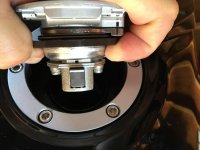Gas Cap Design Thoughts
As a design engineer (fighter aircraft), it seems to me that the gas cap mechanism has a minor design flaw or too tight of a tolerance build up (or both). On the surface, it seems like a functional design - rubber gasket cap combination compresses on the top of the fill tube and the beveled tab in the cap center post locks into a slot on the fill tube when pushed deep enough into the fill tube. (See the pictures below)


The issue is getting the beveled tab deep enough into the fill tube to engage the slot in the tube. To do this, the gasket cap combination slides up a center post, compressing an internal spring, best I can tell.


While that's pretty straight-forward, the issue seems to me to be that the action to close the gas cap and compress the gasket cap combination on top of the filler tube so that the center post with the beveled tab will drive deeper into the tube and engage the slot
isn't straight-forward. What's required is a straight push on the gas cap, in line with the center of the gas cap mechanism and center post. What you're really doing when pushing on the back edge of the gas cap is applying a rotational force, rather than an axial push, since this gas cap assembly is pivoting about its hinge. It's pretty darn close to a straight axial push, but close doesn't seem to work all that well here all of the time. I suspect that since the rotational action on the gas cap results in
both the axial force, which is what you need to slide the gasket cap combo up its axis (or conversely, drive the center post down its center axis),
and a small side force, the small side force is what is preventing the gasket cap combo from sliding as much as it needs to. With a close-tolerance mechanism, which is what you want when sealing a gas tank, I think that any friction between the gasket cap combo and its center post is causing binding, preventing the center post with the beveled tab from driving deep enough into the tube to engage the slot, which allows you to turn and remove the key.
Any rotational force on the gasket cap combo perpendicular to the center axis and the desired direction of travel will inherently cause some binding. I think that's the minor flaw in the design, considering the needed close tolerances between the gasket cap combo and its center post to seal the gas tank. Note that when I refer to the center post, that center post isn't a simple round shape or rectangular shape. There appear to be numerous elements and shapes comprising that center piece, providing many different surfaces about which it could bind.
Based on others recommendations, I sprayed some lubricant around the center post area that is exposed when you compress the gasket cap combo as shown in the fourth picture. Hopefully, this alleviates some of the friction induced by the rotation when pressing on the back edge of the gas cap to get it to close. After doing that, it did feel like it closed a bit easier, but I suspect this isn't a permanent solution. I imagine that I'll periodically have to lube it. In the mean time, I hope it works well enough that my wife is no longer concerned about riding her Spyder alone. I think she has a legitimate concern about not being able to close the gas cap when on her own at some remote/random gas station.
I looked at this design a bit more critically, as an engineer, when it took me the better part of 15 minutes to get the gas cap closed on my wife's newish (3,100 miles) F3-T and considering the fact that the effort required to close the gas cap was nowhere near consistent on both of our F3's. Anyway, my two cents as a design engineer of nearly 35 years... This and lots of spare change will get you a cup of coffee!




